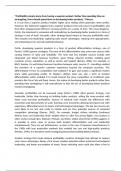"Profitability simply stems from having a superior product. Rather than spending time on
strategizing, firms should spend time on developing better products." Discuss.
It is true that a superior product enables higher price setting which generates more profits.
However, the statement suggests that a superior product is the only source of profitability, and
that other strategy-based efforts to increase profits are a waste of time. This essay disagrees.
Firstly, the statement is somewhat self-contradictory as developing better products is a form of
strategy in and of itself. Secondly, other strategy-based means to increase profitability exist.
This includes cost leadership, capturing early mover advantages, reducing rent appropriation,
and minimising errors and sub-optimal behaviour.
Firstly, developing superior products is a form of product differentiation strategy, one of
Porter's (1985) generic strategies. The basis of this differentiation may arise from sources with
varying extents of rarity and imitability. The rarer and less imitable sources include well
integrated and linked business functions, good timing, physical location enabling good
customer access, reputation, as well as service and support (Barney, 2002). For example, in
IBM's heyday, its well-linked business functions between sales, service, IT, consulting enabled
the provision of a superior customer experience beyond the computer purchase. This
differentiated it from its competition and enabled it to gain and sustain a significant market
share while generating profits. Dr Pepper's distinct taste was also a form of product
differentiation which enabled it to break beyond the price competition of traditional soda
products like Coca Cola and Pepsi. Hence, the notion of developing better products rather than
spending time strategizing is self-contradictory in that the act of developing better products
involves strategizing.
Secondly, profitability can be increased using Porter's (1985) other generic strategy: cost
leadership. Rather than focusing on building better products, selling the same product with
lower costs increases profitability. Sources of reduced costs include size differences with
economies and diseconomies of scale, learning curve economies allowing decreased cost with
experience, differential access to inputs, and technological advantages. The last two sources are
most likely to be rare and costly to imitate and are thus potential sources of sustained
competitive advantage (Barney, 2002). For example, budget airlines including Southwest
Airlines have cost leadership which enables them to offer low priced flights. Cost leaders in
other sectors include Ikea, Walmart, Primark, and Shein. Unlike what Porter (1985) suggests, it
is possible in some cases to pursue both product differentiation and cost leadership
simultaneously. They are not dichotomous, as seen in the case of Japanese manufacturers in
the 1980s with lean production methods that enabled low cost and high-quality products
(Hendry, 1990). It is therefore worth strategizing beyond just building better products.
Another strategy that could enhance profitability could be strategies that attempt to capture
early mover advantages. Being a first mover enables potential patent protected technological
leadership, and better pre-emption of assets. Buyer switching costs could also allow a firm to




